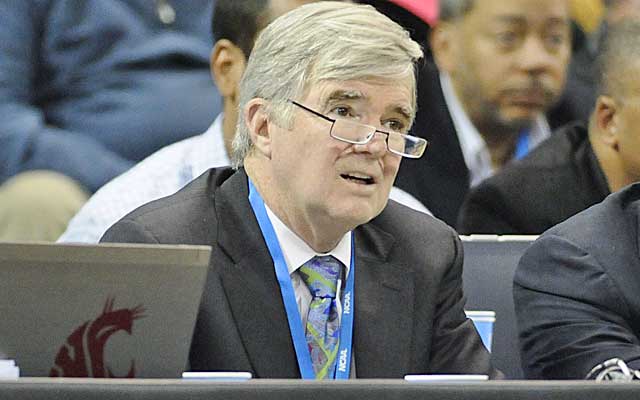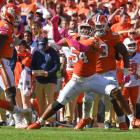
More: O'Bannon news | On CFB: Dennis Dodd | Jeremy Fowler | Jon Solomon
Llamas come to mind.
Perhaps lemurs.
Definitely some high-functioning land mammal.
Think, for a moment, of what fans would still cheer for if -- as the NCAA suggests -- the collegiate model were altered. At this crossroads in history, we're suggesting that 22 yetis could put on the pads. Still, some measure of Michigan-Ohio State, Alabama-Auburn, Florida-Georgia loyalists (pick one) would pay $95 a pop to watch.
To some persons, somewhere, it would still be college football. It would still be worth tailgating, spreading a blanket, going to the pep rally. It would still elicit the same emotions that rise in the chest of millions when they return to the alma mater's campus on a fall Saturday.
It's a stretch analogy, perhaps, to mix an Andean pack animal into the discussion. But if Banana Slugs can share NCAA revenue, then the point can be made.
Those instilled feelings, those emotions, decades of tradition, will not be stripped away by any court battle. College sports in whatever altered form that emerges from the current NCAA makeover and legal challenges will thrive.
There are still going to be innocent teenagers maturing into young men doing remarkable things in four years, until they're replaced by the next round of athletes. Compensating them a few thousand dollars isn't going to disrupt that unbroken circle.
That's the enduring lesson as the landmark O'Bannon trial ends Friday. The NCAA remains diligent in its fight on multiple legal fronts to preserve its particular version of amateurism. But is that fight worthy or even just?
Folks will still watch whether or not the next Johnny Football makes an extra $5,000 beyond his scholarship. They will watch whether or not he gets another $5,000 from some sort of licensing deal for his autograph. They will watch even if players get some split of jersey sales.
Once again: The games are too great. The attachments are too lasting. The emotions too deep. The suits who run these vast enterprises won't let that go away. There are too many people making too much money to let things sink into some court-ordered semi-pro slopfest where no one is happy.
Out-of-court settlements aren't an admission of defeat. The NCAA is more than familiar. It will adjust. Remember, this is an organization that once opposed Title IX.
At issue for the moment is how to label some of that extra cash. Cost of attendance, everyone seems to be behind. That would be some sort of cost-of-living stipend.
Meanwhile, back at O'Bannon, negotiating with players over their names, image and likeness (NIL) has the NCAA trotting out the same, tired sky-is-falling defense.
That would be "paying" players and we can't have that. (Sarcasm added.) Except we're already there -- and some of it is overdue. As colleague Jon Solomon suggested this week, the rush to this moment started 30 years ago.
The imbalance between rich stakeholders and unpaid athletes putting their bodies on the line became too great. Doesn't the mere fact that we're debating whether athletes on $50,000-per-year scholarships need additional funds, prove those stakeholders have lost control of the discussion?
"Let me ask you this," former College Football Association executive director Chuck Neinas told Solomon. "If the money wasn't there, would there be litigation? No, of course not. But the money is there."
Funny, those attorneys weren't rushing to file NIL cases before video games were invented.
Now it's the long, hard slog toward distributing that bloated pot of cash fairly. The NCAA prefers it above the table and closely regulated. They may not have a choice. See: unionization, Northwestern.
Former CBS Sports president Neal Pilson boiled down the issues early in the current O'Bannon trial.
Asked by an NCAA attorney what figure would he be comfortable paying players, Pilson responded, "I'd tell you $1 million would trouble me and $5,000 wouldn't."
It struck me at that point: $5,000 is more or less the annual price of cost of attendance, a player-compensation concept now accepted by the majority. Does it really matter how the distribution is labeled?
We are, then, arguing semantics.
We should be celebrating servicing long-underserved athletes. That includes the prospect of better medical care and insurance coverage in autonomy. That includes an active voice in legislation for the first time. Fifteen of the 80 votes among the Big Five conferences in autonomy are expected to go to athletes.
What a concept, athletes getting what amounts to realistic input into working conditions. Almost sounds like a union. But because it would be NCAA-sponsored and autonomy-endorsed, it's OK.
See? Semantics.
Athletes will be rewarded because they're … athletes who happen to be on scholarship. It's OK to admit they are better physically -- though not necessarily less cerebral -- than those music and math majors.
In that sense, that precious collegiate model -- the NCAA's principle of amateurism -- almost collapses in on itself.
That principle states that sports is not a vocation but "an avocation" blended into the educational experience.
"[But] if you're getting paid does that mean you can't be pursuing [sports] as an avocation?" said former NCAA enforcement director Julie Roe Lach. "I don't know."
Historically, amateurism has been a moving target for the NCAA. The first NCAA constitution prohibited "inducements to players to enter colleges … because of their athletics abilities."
Isn't that what we call an athletic scholarship today?
"Gradually, year-by-year, decade-by-decade the line moves," said Dave Revsine, Big Ten Network host. "What was once not palatable is acceptable."
Iron-handed former NCAA executive director Walter Byers would have blanched at an accepted practice in this age. Players are allowed to accept up to $550 in bowl gifts.Fairly lavish gifts.
Does that professionalize players?
Hard-liners say a scholarship is enough. According to a document obtained by CBSSports.com, the price of the average Kansas State athletic scholarship is more than what 40 percent of the school's employees earn in a year.
Does that professionalize the athletes?
It wasn't until 1974 that players could be professional in one sport -- example: baseball -- and still be considered a college amateur.
Ten years ago, the idea of paying players a stipend over and above their tuition was stagnant. In fact, six years ago the NCAA was fighting vigorously against the concept before settling a lawsuit.
Two-and-a-half years ago, the NCAA membership voted in a modest $2,000 stipend only to have it die because of an override vote.
Today we're looking realistically at filet mignon at training tables. The welfare of the athlete is at the center of every big decision. As it should be.
"It's not altruism," said Revsine who has written The Opening Kickoff, chronicling the early history of college football from 1890-1915.
"When push comes to shove, most of these guys do what's in their best interests."
Not much, it seems, has changed. The game's earliest rules, Revsine said, had to do with eligibility. Back in the day the presidents of what would become the Big Ten passed a rule saying players actually had to be enrolled in school. Then widely ignored it.
"They were doing this," Revsine said, "because they realized football ruled."
There were sub-standard medical protections. Players actually grew their hair out to guard against concussions. Coaches were paid as much as the school president.
During O'Bannon, an NCAA witness produced a survey that concluded 69 percent of the public don't favor paying players. I was more impressed by the suggestion 31 percent do.
That proved it for me. Obviously, something has changed out there in the group think. Whether they're llamas, lemurs or traditional human linebackers, we'll continue to watch.
Emotionally, traditionally -- and financially -- we're too invested.




















